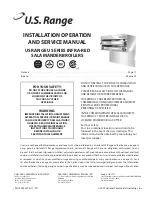
53
14
Health and Safety Information
Under the Consumer Protection Act
1987 and Section 6 of the Health
& Safety at
Work Act 1974, we are
required to provide information on
substances hazardous to health (COSHH
Regulations 1988).
Adhesives, sealants and paints used in
the manufacture of the product are cured
and present no known hazards when
used in the manner for which they are
intended.
The following other materials are present
in the product:
14.1 Insulation Materials
Material Types:
Ceramic fibre board,
mineral wool.
description:
Rigid board, slabs, sleeves,
gaskets, ropes.
Known Hazards:
May cause temporary
irritation or rash to skin. High dust levels
may irritate eyes and upper respiratory
system.
Precautions:
Avoid unnecessary or
rough handling, or harsh abrasion of
boards. Normal handling and use of
material should not produce high dust
levels.
Avoid inhalation, and contact with skin
and eyes.
After handling always follow normal good
hygiene practices.
Protection:
Use disposable gloves, face
mask and eye protection.
First Aid:
Eyes - If irritation occurs, wash
eyes with copious amounts of water.
If symptoms persist, seek immediate
medical advice.
Skin - If irritation occurs, wash under
running water before washing with soap
and water.
Inhalation - Remove to fresh air, drink
water to clear throat and blow nose to
remove dust/fibres.
Ingestion - Drink plenty of water.
14.2 Insulation Materials
Material Types: Silicone elastomer.
description:
Sealant and adhesive.
Known Hazards:
Irritation to eyes.
Precautions:
Avoid inhalation of vapour,
contact with eyes and prolonged or
repeated contact with skin.
After handling always follow normal
good hygiene practices.
Protection:
Use eye protection. Rubber
or plastic gloves should be worn where
repeated contact occurs and a face
mask worn when working in confined
spaces.
First Aid:
Eyes - Flush eyes with water
for 15 minutes. Seek immediate medical
attention.
Skin - Wipe off and wash with soap and
water.
Inhalation - Remove to fresh air.
14.3 Kerosene and Gas Oil Fuels
(mineral oils)
Known Hazards:
The effect of mineral
oils on the skin vary according to the
duration of exposure and the type of oil.
The lighter fractions remove the
protective grease naturally present on
the skin, leaving it dry, liable to crack
and more prone to damage by cuts,
abrasions and irritant chemicals.
Skin rashes (Oil acne) most often on
arms, but also on any part of the body in
contact with oil or oily clothing.
Contact with fuel oils can cause
dermatitis.
Precautions:
Avoid as far as possible
any skin contact with mineral oil or with
clothing contaminated with mineral oil.
The use of a lanolin-based barrier cream
is recommended, in conjunction with
regular washing with soap and rinsing
with water to ensure all oil is removed
from the skin.
Take care to prevent clothing,
especially underwear, from becoming
contaminated with oil.
Do not put oily rags or tools in pockets,
especially trouser pockets.
Have first-aid treatment at once for an
injury, however slight.
Do not inhale any vapours from mineral
oils.
Health and Safety
Information












































